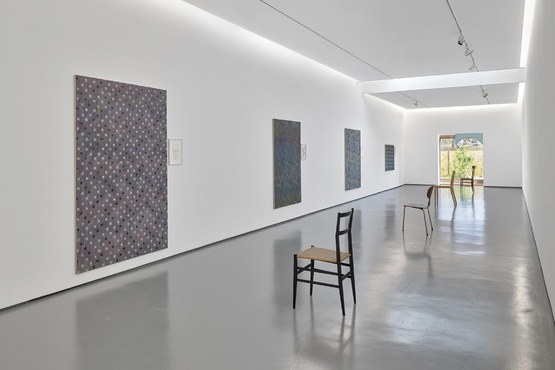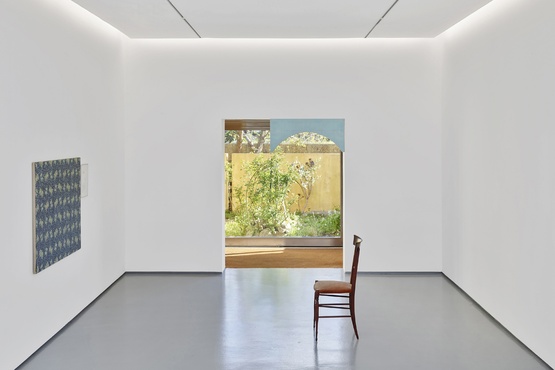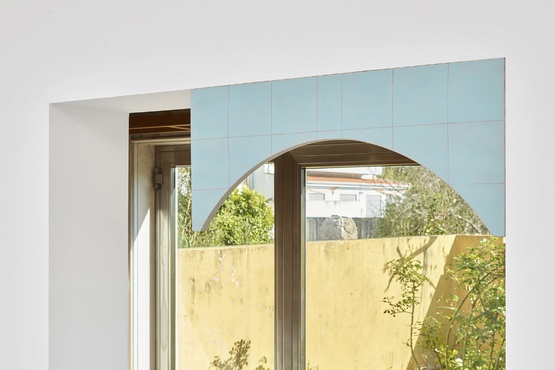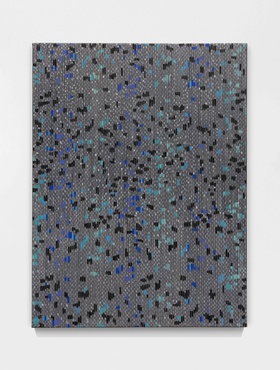Far
from the Fireplace
Bassline is the title of João Marçal’s new exhibition in the gallery
Quadrado Azul in Porto. The title refers to Marcal’s double album, Heart Frostbite, that he will soon release
thanks to Porto City Council’s artistic creation support programme, Criatório.
This will be his first album since Group Show, that he released in 2015.
The paintings and drawings in Bassline are related to the songs of Heart
Frostbite, including tracks such as Drunk Optometrist, En la calle
or Diapers for Adults. Marçal considers that the bass guitar plays a
role similar in music to that of painting in the visual arts. Like the bass
guitar, painting is a structure that "wraps around" things. It is very
different from drums, for example, whose prime function is to "set" the
rhythm. Painting can also be understood as a bassline, from the point of view
of Art History; i.e. as the background of all Western art. Sometimes more
present, sometimes less, but always there.
Unlike his other recent exhibitions - such as Inner
8000er, in the Pavilhão Branco, in Lisbon (2018), that mainly featured
paintings; or Dzi Bead, in the Quadrado Azul gallery, in Lisbon (2019),
in which he experimented with large scale murals - in this new project, Marçal
wanted to emphasize the relationship between two scales, painting and drawing,
creating a dialogue caused by juxtaposition of works, like diptychs, on one of
the gallery walls.
In addition, Marçal decided to install a chair in
front of each of the paintings, able to be used by visitors. The chair
introduces the human scale and establishes continuity with his other works,
such as the pole from a metro train in his Dzi Bead exhibition. On the
opposite wall, the exhibition concludes with a painting that reproduces a
detail of the fireplace in the home of one of his partner’s relatives -
following a logic similar to the work that refers to the bathroom of his old
apartment in Porto, shown in the Pavilhão Branco, thereby creating an environment of domestic
reminiscences, which at the same time is uncanny.
The paintings are inspired by the upholstery of buses
that run between Portugal’s rural areas and the capitals. The drawings, on the
other hand, refer to the imagery of comics books, of which the artist is fond
(in particular those by the artist, Jiro Taniguchi). The paintings are
abstract, while the drawings are figurative, which means that they seem to be
completely unrelated. Nonetheless, they still influence each other. In fact,
drawing in general could also be defined as the "bassline" of
painting; the structure that underpins the most visible and accessible part of
the work, a bit like the guitar and the vocalist's voice in a band. In terms of
the content, the relationship between upholstery and comic books is related to
memory and perhaps to nostalgia for another life.
The upholstery of buses is a recurring theme in João
Marçal's work. It first appeared in 2012, in his exhibition Dona MariaAmélia.
This recurring theme is related to the need to maintain an umbilical cord with
the past. More specifically, with the social environment that accompanied and
nurtured him during his childhood and adolescence - until he moved to Porto to
study Fine Arts. The environment of these buses consisted of misfits who,
despite everything, were unable to travel by private car and therefore used
more modest travel options, such as public buses or coaches run by local
private companies. It was mainly formed by students, people with few resources
and the elderly. A bit like the Greyhound buses – filled with renegades, drug
addicts and fugitives, who are part of the American literary and cinematic
imagery.
The paintings made from the upholstery of buses and
trains have a peculiar behaviour because they are not what they seem: the
fabric is reproduced in such a way that it looks authentic, rather than
represented. This forces the spectator to draw close and then move away, to
check the reality of the objects he or she is seeing. This illusionist
behaviour was already present in Marçal’s previous exhibitions, such as Dzi
Bead (2019), and is now repeated in works such as Above the Clouds.
A-B-O-V-E-T-H-E-C-L-O-U-D-S, Lisbon (-Porto), Emotionally Homeless or Foggy
Dawn. Frames composed of patterns with a generally dark background and
geometric or arabesque structures in lighter, more luminous tones, superimposed
on the foreground, whose effect distracts the human eye, making it possible to
conceal or hide dirt and stains. Colour is absent in the grotesque drawings -
such as the dog barking or the head of an elderly man with Bart Simpson's hair
– which nonetheless share the popular or familiar vocation of upholstery.
With Bassline,
Marçal has consolidated and expanded his language. Sometimes in a radical manner,
as happened in his recent exhibition at the Quadrado Azul gallery in Lisbon, in
which he surprised visitors with a set of new works that interacted with
architecture.
Marçal is one of the Portuguese artists who has best
and most intensively rethought painting in Portugal, both in terms of
historical references (Stella, Noland, Palermo, Polke, Krebber ...), as well as
local references. He belongs to a generation of new Portuguese artists (Sónia
Almeida, Ana Cardoso, Joana da Conceição, Ana Manso, José Loureiro, André
Sousa…), who are renewing and transforming the modern tradition initiated by their
predecessors - artists such as Eduardo Batarda, Ana Jotta, Álvaro Lapa, Ângelo
de Sousa ...
In this context, João Marçal's painting is
distinguished both by its intense self-referential character and his love for
the vernacular and the popular, creating a very productive and personal
dialectic: first and foremost, because his painting is intensely biographical,
although it doesn’t seem so at first glance. This is something that is present
in the way that he approaches his personal origins, for example, in the
self-portrait he produced for his master's degree project (MPAC) in 2008, in
which he wore his favourite polo shirt and beloved Reebok Classic sneakers. His
painting is also self-referential because it is a reflection on the medium
itself: "There is always a layer in all my works", he stated in 2018,
"which refers to a thought about the painting itself, as a genetic
analysis of the environment itself, intrinsic to the entire practice. " (Inner
8000er: 2018, 10)
Between its self-referential nature or abstract and
popular references, we can imagine João Marçal travelling by bus from Coruche
to Porto, while reading a comic book or drawing in a notebook. His paintings
and drawings emerge from the conflict between this personal reality and the
formal culture of school, artistic institutions and museums. They thereby
achieve a kind of synthesis between his personal origins and the new social and
cultural contexts in which he has lived since then. Another way of interpreting
the bassline that is referred to in the exhibition’s title - always
present, but discreet - would be to see it as a kind of deep or subconscious
voice that emerges in these works with a certain melancholy mood that coexists
with the brightness and superficiality of this mirage that we call
"contemporary art."
Pedro de Llano, March 2020






